benjaminrhesse
You can scroll the shelf using ← and → keys
You can scroll the shelf using ← and → keys
Final Reflection
The journey of the hero! Not sure if I am a hero in the land of digital storytelling, but I have answered the call nonetheless: from cosmos, to chaos, to a return home, this class has been an amazing journey. At the start of 5340 I didn’t even really know how to use Twitter! Well sorta… However, Brad set the expectations high per using the blog to synthesize our work and reflect, to use Twitter to post and share, and utilize Hypothes.is to annotate articles and video as a community of learners. I tanked pretty hard out of the gate as my first blog post below shows. I didn’t embed my work, I didn’t link properly, and overall it felt pretty uninteresting. This was the call to adventure and I bumbled along until crossing the threshold. Ach…
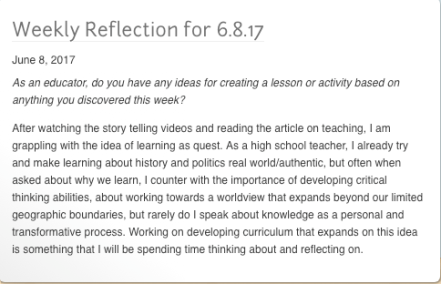
Sage advice was offered and I worked harder to become a stronger digital storyteller. I used all of the assigned mediums to tell my story. Here is my media scorecard:
Video:
-vintage futurism with snake pliskin track and NASA space footage
-30 second story of AM hours with/without coffee
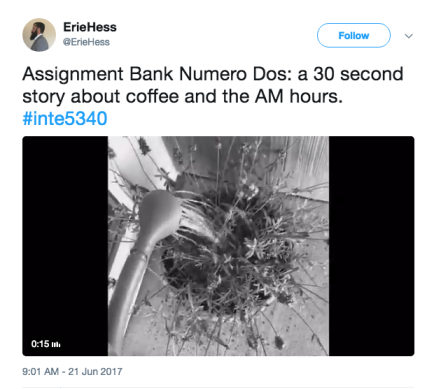
-week 8 reflection song – see below
Audio:
-the home recording/audio of SP for the vintage futurism assignment
-remix of Monica Avila Beal’s reflection as text to voice with beats
-week 8 reflection song
Dialogue:
-nyu philosophy professor Bob Gurland digital ethnography analog tape to digital
-ds106 explanation and conversation with my mother about teaching and technology
-week 8 reflection podcast co-create w/DDM – see below
Web:
-remix the news: trump and eastern european food preferences
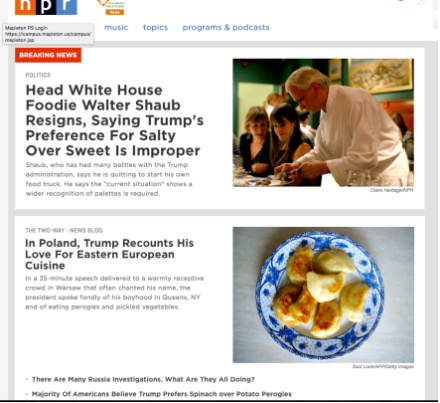
-colorado brewery favorites map/story – see below
Graphics:
-pictionary pop culture lorde summer jam
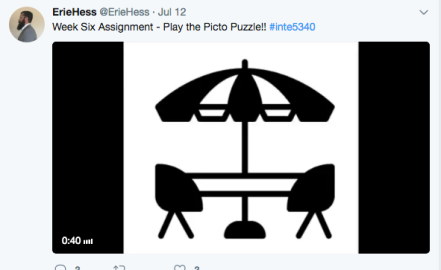
-twitter photo essay on portland, oregon vacation

Social:
-twitter photo essay on portland, oregon vacation
-twitter fiction about eastern plains pot growing

——————–>>>>>>>>
Week 8 Work:
Podcast with DDM for week 8 reflection – this 20 minute dialogue went after the main aspects of the final reflection. This seemed like a natural way to co-create and synthesize our thoughts on the course. We had fun! We discussed objectives, having/doing/being/knowing, favorite moments, take-aways, stretching, and our picks for summer jams. It was a 45 minute discussion that we edited down in order to accent the key aspects of our work. We hope you enjoy it.
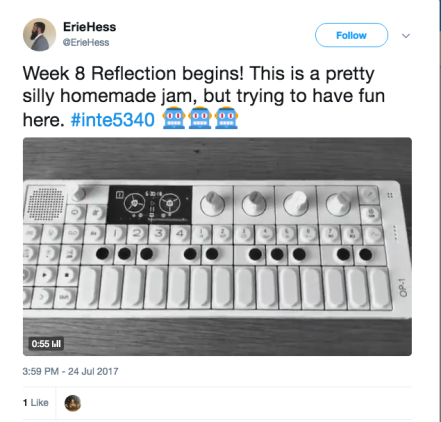
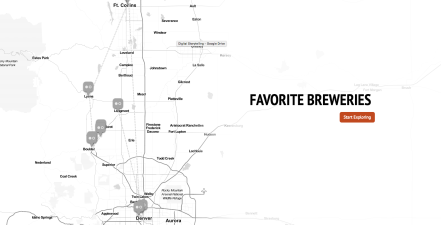
Final thoughts? my Google Cardboard VR setup came in the mail today. I have become a participant and a creator of digital media. I now wear the badge proudly!
Goodnight sweet prince. You have them on backwards 🙂
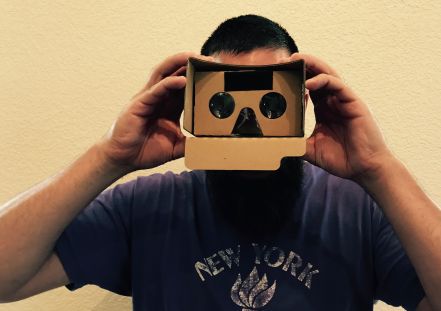
Week seven. Seven weeks. One left and I graduate from CU Denver’s Culturally and Linguistically Diverse Education program. This was a tough two years of working full time as a high school teacher and taking night courses, driving into Denver for class, and spending weeknights/weekends reading and writing. Almost there! In week seven of my digital storytelling class we were asked to step it up with two assignments, but were given a break from our usual readings and annotations.
Daily create one: https://roboboogie.codeclub.org.uk/#watch/596cefb5da513
What a fun robo boogie coding exercise. You were able to adjust the speed and movement of the robots head, arms, and legs all the while choosing background music and the type of bot. It was silly and easy. I decided to do another to stretch myself.
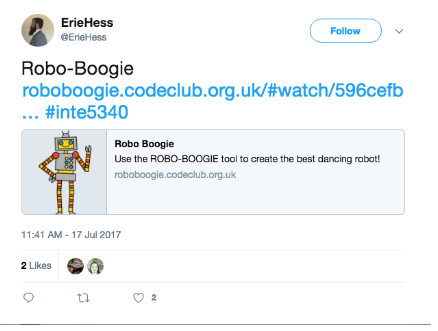
Daily create two asked you to find something in your home that made a horrifying sound. I went to my OP 1 and scanned through the synth bank until I found a pad that a haunted vibe. I don’t think playing a major chord made it quite scary enough, but I added a filter and went in for a closeup to increase intensity.
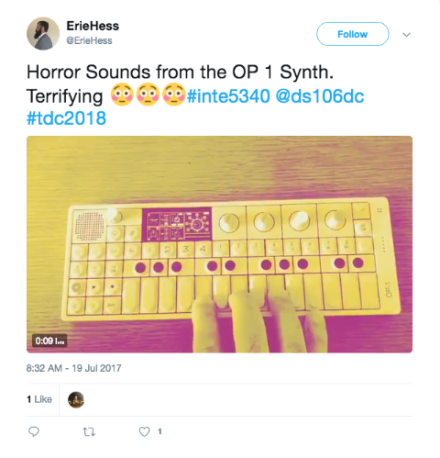
According to my own media checklist I have three remaining categories to finish off: 1 web, 1 social, and 1 dialog. To fulfill my social this week, I chose to do a short story on Twitter that reveals a sequential aspect of the story each day. I will post for 5-6 days in a row, adding more plot, setting, and character development all within the 140 character limit.
I watched a Ted talk on the new forms of digital storytelling that are taking place on Twitter relating to anonymity, controlling the pace of reading/the reveal, reader feedback, etc… It was interesting to hear about how creative and inventive people are being with this platform. Here are the first four days of my fictional story. You can read the finished work on my twitter feed. No spoilers!!!

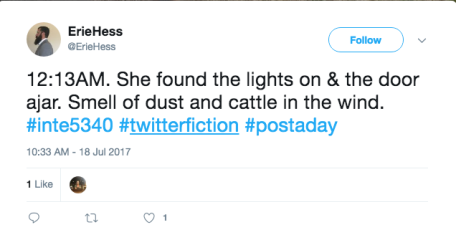
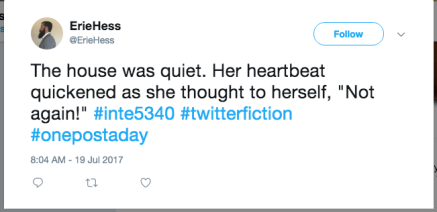

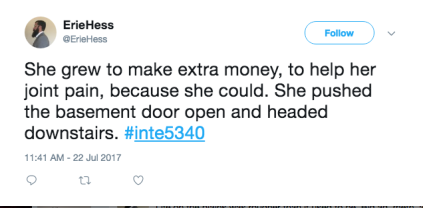
My final assignment is a dialogue with my mother, who also taught. I explained DS106 to her and recorded her responses and thoughts on the class. It was a nice excuse to get together and hang out. As always, she had something interesting to say.
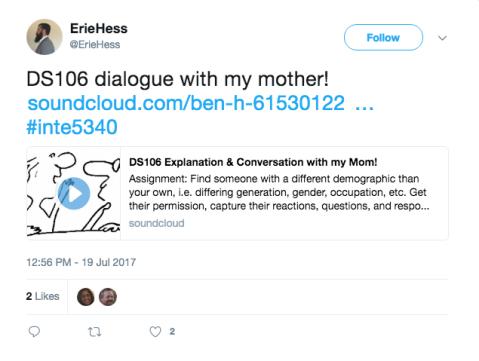
My crit is related to Google VR Cardboard and the role it is playing in expanding educational opportunities for classrooms around the world. I bought a pair and am interested in seeing if the technology will be a good fit for expeditions in my classroom. Fingers crossed! The package has yet to arrive!
In conclusion, week seven focussed on dialog and soliloquy. Digital dialog to me has a pretty open ended definition. It can run the gamut from a social media “like” to something more specific like an Twitter comment/response, to discussions in online forums, to more in depth sharing and co-creating of digital mediums. You create something and people respond to it, building a shared narrative. It requires familiarity with platforms, being involved with community, and being creative. Soliloquy is your voice, your story. It can operate on its own or it can be part of a larger group of stories that exist in parallel. Harnessing the digital tools that give our voice is essential for both dialog and soliloquy to manifest. We learn by sharing, inspiring, refining, and working together.
Google VR is something I have been thinking about using in my classroom for a few years now. Basically, they are some advanced Mattel View Masters. You place the goggles up to your eyes with your phone inside the frames, and are able to watch these specially designed 360 degree videos. You can walk around in the recorded video field and interact with various features. I have not experienced the technology first hand, but watching the videos, looking at the stills, and reading the reviews, it looks pretty interesting. Low cost and simple to use? Interesting…
Google has an app that teachers can utilize called Expeditions that allows you to take students to various locations and conduct virtual field trips. You can even make your own if you have the technology to do so. I watched a teacher from Georgia demonstrate a visit to Everest. The teacher narrates/mediates the field trip by pointing out key elements of the site via reading notes and adding arrows that help students map the site.
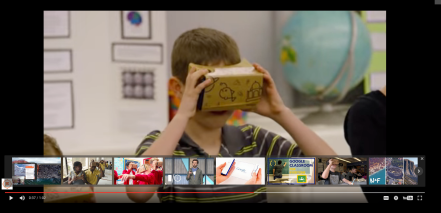
Being a reader of the NYTimes, I have noticed an increase of VR offerings that utilize Google Cardboard. They even sent out batches of the goggles to subscribers to promote interest and educate readers on the technology. 
In terms of the weekly theme of Dialog and Soliliquy, I feel that if teachers and students can get a handle on the technology and create their own 360 degree VR expeditions, it would be an amazing way to show/share with students and learners from other parts of the country and world. Instead of just recording an oral history via voice recorder, a student could go on a walk with their interviewee and record the surroundings/neighborhood in order to highlight visually the story line. In terms of teaching geography and culture, this tool seems limitless. This kind of VR tech allows for a level of engagement and immersion that other forms of media lack.
The downside to this “low cost” technology is that your school needs to have one to one technology, specifically an iPod touch or smart phones to work with the VR viewer. You can have the students use tablets for 360 degree viewing, but there is no cardboard tech to supplement the larger devices. Thinking about bringing this into my classroom, we would only be able to use tablets since the district does not allow students onto the wifi with their personal devices and not everybody will have a smartphone with the proper specs. That is sort of a bummer, but I think that I could make use of the tablets and go from there.
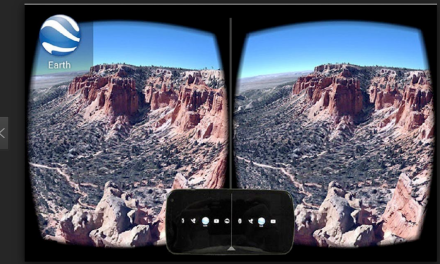
I am going to purchase a pair today and work towards incorporating them into my classroom curriculum. Excited!
Weekly Reflection
Man. I am trying to stay with it, but the slump is here. Two weeks left and my momentum to create, to think, to question is hitting a slow down. I am generally enjoying learning about new literacies and digital storytelling, but I am two weeks away from finishing my second master’s degree and I have some serious senioritis. Noooooo!
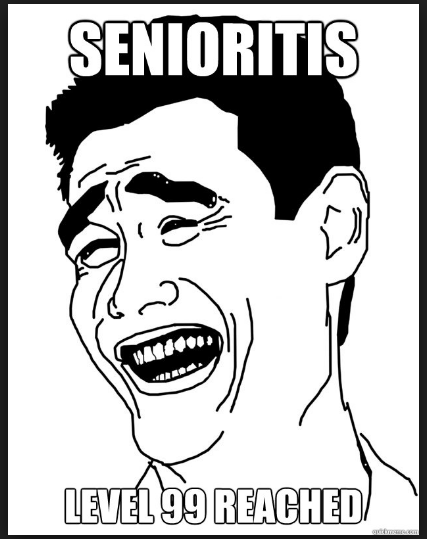
The Daily Create:

John Muir meets 2017 political/internet language – Dumpster Fire. One of my favorite phrases from this year.

My assignment for week six was a graphic video that I created using the pictogram bank from Canvas. I took screen shots of words/phrases, imported them into iMovie and put a quick quiz together. It took a little while to fine tune it, but I am pretty happy with it.

The critique came from 18 in the Bay which is a digital zine of sorts that high school students from the San Francisco area created with the help of their teacher and Medium. It is pretty stunning and somewhat controversial. Read my analysis for more next door.
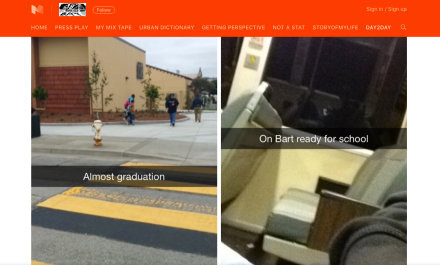
I enjoyed listening to my classmate DDM’s digital ethnography – https://twitter.com/DDM89771257 – about the intersection between authentic learning and teaching. The interview was interesting because the topics hit home this week and connected back to 18 in the Bay and finding voice in new literacies. When teachers and learners take each other seriously, when assignments are authentic and involve stretching oneself and working towards self realization, strong work is produced. Thanks DDM.
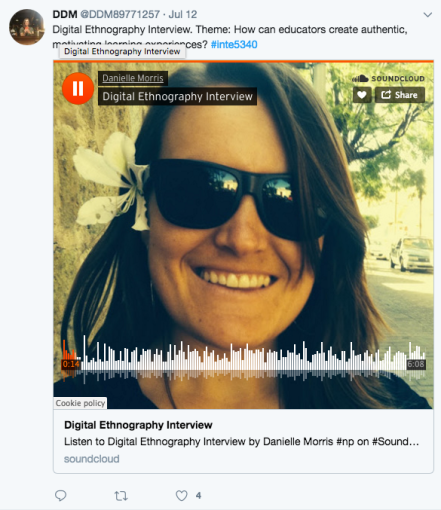
What do I have to say thinking back on the week? Honestly not enough. I think I will just leave you with my jam for the week: Arcade Fire’s new new. Album drops soon and this is a nice critique of digital/modern life.
18 in the Bay is like like a bizarro senior yearbook: uncensored by faculty, raw and honest because it is devoid of posturing, and youth centric. It is pretty beautiful. I am impressed the teacher, students, and Medium put it together. There are numerous projects students are asked to complete that range from an urban dictionary, to using SnapChat to document a day in the life, to interviewing someone for a sense of perspective. It utilizes multiple digital platforms to help students examine and reflect on their final high school year and it is made public. Thinking more about it, the site is really a digital zine.
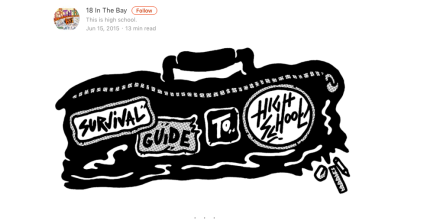
In terms of the weekly theme of “New Literacies” I am finding connections between having the students utilize their familiarity with social media as a way to capture and reflect on their lives. Their storytelling is not simply a written essay, or a powerpoint, but rather a combination of writing, music, and photography all incorporated into a blog. I would be interested to see the teacher’s instructions, expectations, rubrics, and grades for these assignments. I also wonder how much the Medium team helped the students and staff with framing and facilitating this project. Looking over the survival guide it got me thinking about voice as well – it feels like most of this project is the voice of the students. I don’t really see the voice of the teacher, or their presence. Having projects that give students agency and voice is important – it sounds like teenagers, it looks like teenagers.

That said, when thinking about incorporating a project like this into my own classroom I am struck by how little censorship there is. There is a massive amount of cursing, slang, drug related discussions, and I don’t think that putting this in the public sphere would fly at my school. I wonder how they pulled this off? It just seems so totally beyond the pale in terms of what kind of output is allowed for a school. I am not saying that students should be censored in general, but I know I would probably face massive disciplinary action if I allowed this type of material to be part of a class. Now I have done oral histories and zine projects that are similar to this in some ways and we edited the text and photos. We had to. When we did this, it limited the voice of my students, but it was the framework that we were working within and followed the rules.
Reading through the blog I was also struck by the privacy issues that surround some of this. There are so many pictures and personal stories… These very raw and honest portrayals walk the razor’s edge between privacy and art. I know students today post many things on social media, but there does seem to be a line crossed here. I guess I am just old fashioned… Overall, I would love to do something like this with my students because I know that they would dive in and create amazing work, I would just frame it differently.
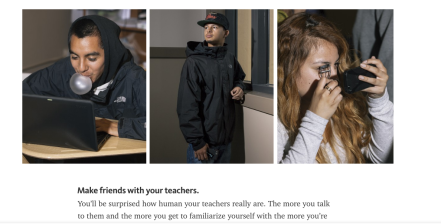
This was a busy and compressed week. Being on vacation in Portland, celebrating Independence Day, and having only my phone to access assignments, read, and post made things interesting.
I planned ahead of time to create a twitter essay for the first of the assignments. Planning ahead allowed me to interpret my visit to Portland through the lens of our class and social media. A twitter essay is supposed to carry over at least three tweets and tell a story of some sort. Researching this unorthodox approach to essay writing I found teachers using it in classrooms via rough and final drafts, people utilizing it for how to lessons that brought in photos and video, and my general take away was that I could approach it with a lot of freedom. I stitched together five tweets with 3-4 photographs per each that focussed on portraying the landscape from three different perspectives – looking down, eye level, and looking up. I left the themes pretty open and just tried to find things that caught my eye. I am happy with the final product and I really enjoyed having to create something interesting every day. Thanks Brad!
Vacation in Portland #twitteressay. Enjoying: sea level altitude, cloudy days, verdant landscapes, and ☕️. #inte5340 #week5 pic.twitter.com/gljLmYK5W9
— ErieHess (@ErieHess) July 2, 2017
PDX Essay: a perpspective based approach to a new place. I’ll focus on observing by looking down, at eye level, and things above. #inte5340 pic.twitter.com/AJYn0z1Q9b
— ErieHess (@ErieHess) July 2, 2017
PDX Essay Looking Down: finding beauty in cement sidewalks of various neighborhoods. Date markers, locations imprinted, industrial #inte5340 pic.twitter.com/wQAh8Rjqdn
— ErieHess (@ErieHess) July 3, 2017
PDX: viewing eye level progressive signage, bridges, and wheat paste art. #inte5340 #twitteressay pic.twitter.com/PPEJ5HusBf
— ErieHess (@ErieHess) July 4, 2017
PDX: final perspective on looking up: skyline. Bye Pacific NWest!! Will miss you 🛫🛬#inte5340 #twitteressay pic.twitter.com/8dmyfu6Ewt
— ErieHess (@ErieHess) July 5, 2017
The daily create from this week also involved photography as you were asked about your – “growlery grou-‘ler-ē noun; a place of refuge or retreat when one is out of sorts or in ill-humor.” The daily asked us: What does yours look like? Show us in a sketch, photo or any way you like. It may not be a physical place. I chose daybreak on the eastern plains of Colorado where I always find a level of quiet and calm. I pulled a photo from a recent visit and added text. It was a simple assignment, but I was thankful for it since the week feels rushed.

My second assignment was web-based: hack the news. We were asked to use Mozilla’s X-Ray Goggle app in the bookmark section of our browser and rework text and images found in current news websites. It took an hour or so to figure out the html coding and what not, but I was able to redesign the NPR site to remix food & politics. I enjoyed this immensely.
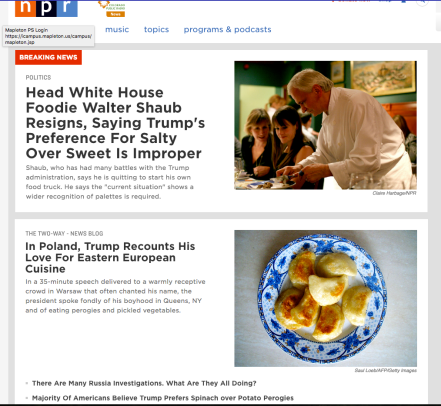
My final assignment was a critique of the literary journal Five Dial’s The Role of Music. It was a questionnaire and story wrapped up in one. Read my previous post for an analysis of experimental digital storytelling.
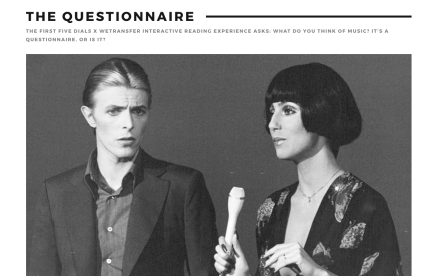
Thinking back on the week, I have really been appreciating the work my classmates have been creating. Specifically, Jasmine Yap. She always adds something interesting, creative, and graphic to our discussions and assignments. Here are two examples of her work this week:
The theme of finding one’s voice amidst the polyphony of modalities is difficult, but extremely enjoyable. As cliche as it sounds, I feel the more you put into this type of class, the storytelling, the assignments, the more you get out of it. The more you experiment with different digital platforms, the easier they become, the more you are able to clearly communicate your ideas and have fun with the process. Onto week six!

Whoah. This was a strange one. The Role of Music is an online questionnaire about music that goes from A to B to Z over the course of 10-15 minutes. The background has a clean white design and as you move through a series of questions, the click of the prompts brings you deeper into a conversation. At first you think you will be getting ranked or clarifying your tastes regarding music, but the intention of this online experiment is something different. You are led into a conversation with the overbearing mother of Carl. She asks you questions about music, child rearing, and over shares about the anger her son has. “Would you like to be his piano teacher?” The narrative moves this way and that, and at times feels like a choose your own adventure book. Finally, you meet Carl and he explains that his life is overbooked, over-planned, and he does not want to learn, or practice, or be required to do another thing – he just wants to sit.

Will you sit with him? Money is mentioned a lot and it gets uncomfortable. Finally, the conversation/journey/experiment ends and you give Carl some tea.
I did a little research on Wikipedia and found out that,
Five Dials is a digital literary magazine published from London by Hamish Hamilton, an imprint of Penguin Books.[1] Edited by Craig Taylor and designed by Antonio de Luca, Five Dials features short fiction, essays, letters, poetry, reporting from around the world (humbly tagged “Currentish Events”) and illustrations.[2] The magazine is free and distributed in Portable Document Format (PDF) approximately every month.[3]
Five Dials does a number of different things, but The Role of Music is listed under their experiment tab. Thinking about the weekly theme of finding your voice, this digital story has a multimodality aspect to it that involves participation via the questionnaire, the story has flashing images that keep you guessing, and it has text. You think your responses adjust the narrative, but after running through the experiment twice, I found that your clicking through and adding input does not alter the narrative, it is just a psychological/placebo button. That said, the story is not apparent at the start and there is an air of mystery to it that gives it a unique voice. Is it about you, is it about your responses, is it about music at all? You are left asking more questions than anything else, and that is a neat way to present a story. You get some background, but overall is experiential.
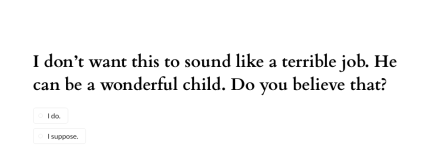
Thinking about how this connects to my own teaching, I see this level of experimental narrative and mystery as offering students a way to create and collaborate using various mediums, all the while trying to push what it means to have a narrative arc/whole. The story as a traditional notion gets upended here, and it would be interesting to have students take the experiment, analyze it, and then relate their ideas back to larger themes. I wonder what they would think about it? Does it satisfy the reader in the same way that a traditional story is read, does it provide any deeper themes or thoughts, or does it just feel experimental for the sake of boundary pushing? Overall, it would be something worth investigating with a class and seeing what kinds of questions and approaches we could come up with when trying to find and establish voice.
——————————————–>>>>>>>>>>> Peer Crit & remix
My remix of DS classmate MAB 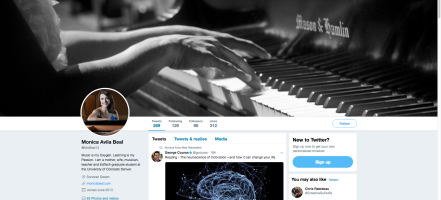
I don’t think it is easy to listen to or terribly enjoyable, but I don’t think aesthetics are always the most important aspects of creativity. Sometimes it can be about the process that is important – remix, remix, remix. Taking written text and making it into audio, taking audio and decontextualizing it by removing certain words, punctuation, changing the rhythm of the language, and then adding filters and beats.
—————————————————>>>>>>>>>>> Digital ethnography
For my digital ethnography I went down into the basement and dug up an old tape recording from 2000 with my NYU philosophy professor, Robert Gurland. I had to play the tape, record it digitally, move it from my phone into Logic, and add a noise gate filter to reduce the background sounds, then edit it down. It is a terrible recording sound quality-wise, but his off the cuff remarks on Truth and Skepticism are pretty deep. He was one of my favorites.

—————————————————————>>>>>>>>>>> Peer remix challenge
I liked the remix action. Animation. Spanish. Yes.
Check out my first REMIX status! #inte5340 https://t.co/bBOZlRZP3q
— Elsa Pranger (@elsa_pranger) June 27, 2017
My take. Spelled fuego wrong.
—————>>>>>>>>>>>> Daily create week four
This is tremendously funny to me because the Queen and Charles are so far removed from what I think of in terms of where NYC and Jewish language, style, and humor are concerned. Putting old/new words into new contexts…
Oy/Yo sculpture by DKass remixed. #inte5340 #tdc1996 @ds106dc pic.twitter.com/MaTFMiDn3Z
— ErieHess (@ErieHess) June 27, 2017
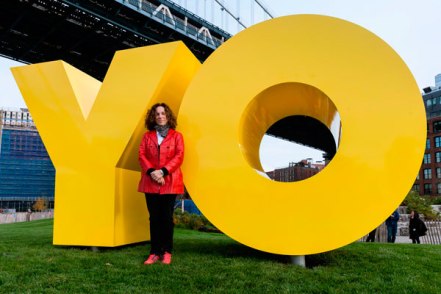
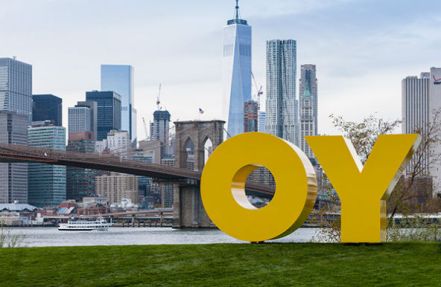
———–>>>>>>>>>>>>> Learnings from the week
Gonna keep it textually short: remixing culture in the digital age has boundaries, borders, and many complexities. It involves a level of meta that requires participants be in the know. It is a dialogue and a communal conversation utilizing digital sampling conventions and open flow between platforms. Creativity is interconnected, borrowed, and building. Reading the the 6/25/17 NYTimes Sunday magazine profile about jazz pianist Craig Taborn, I was struck by the below passage’s alternate view of creativity and remix. What do you think about his anti-remix approach?
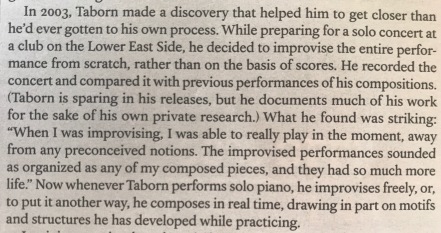
Looking over Monica Avila Beal’s blog, twitter, and various assignments I was struck by how musical, reflective, and personal her work in our digital storytelling class has been. A classically trained composer and pianist, Monica is clearly at home utilizing music and audio in her work. She has incorporated field recordings of typewriter sounds and the ocean to craft a soundscape for her 30 second story – which was very cool. The short involved her time at the beach with her family and playing with the idea of lyrics/a message in a bottle.
It showed a level of spontaneity, creativity, and abstract thinking. Another favorite of mine was her analysis of the 360 degree video depicting what it is
like to live with autism.
She gave a detailed explanation of the topic, connected it back to her son who has Aspergers, and closed the critique on a wry note: a .gif from “Total Recall.” I am glad to hear that at age 13, her son is doing well and finding his way.
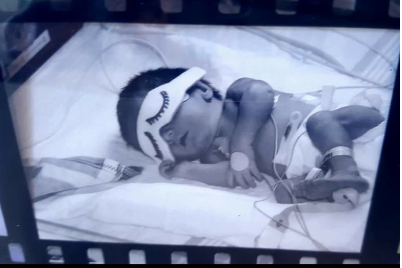
Thinking about how our approaches to this course compare, I would generally say that we both enjoy being creative, have a sense of humor, and are at home in the musical world. I liked this strange “end of vacation” .gif. Ha!
74F Beach vacay has now ended, back to 110F Hell's Kitchen. Wish I was heading to CO #inte5340 pic.twitter.com/S44AGtdquS
— Monica Avila Beal (@MoBeal13) June 27, 2017
//platform.twitter.com/widgets.js
We both reviewed the Anth101 course and had similar reactions – awe, inspiration, appreciation. That said, I find that my sharing and framing of content in this class is less personal than Monica’s. I haven’t shared about my family, shown pictures of my life, or allowed for too much exposure. I guess I am more private in that regard. I am not attaching a value judgement here to either of our approaches, rather an observation. I also am viewing the class through the lens of being a high school teacher – how can I utilize these tools and strategies pedagogically…
I chose to remix some of Monica’s blog text for my transform and combine assignment. I copied text from Monica’s reflection, pasted it into a text to speech application, and recorded various filters into Logic. I then moved the sound files around a little bit to create a staggered replay effect and added beats from a drum sequencer.
I don’t know if it really works, but it felt like a fresh way to approach text and chop it up like William Burroughs. I have been listening to entirely too much Kraftwerk…
Keep up the dope work Monica! I want to hear some piano playing!
Ben
Thinking back on week three, I feel as though the class is starting to take shape – twitter is where everything gets posted, shared, and tagged, hypothesis is the discussion forum for articles and videos, and our blog is our main delivery system for putting it all together. This week was a little more in the weeds per the topic of copyright/fair use and the open source education, but I enjoyed it. It got me thinking about education and platforms for community participation, sharing, and creative exploration. I think in general these are exciting ways to view and transform educational practices, but the site/class I focussed on – Anth101 – had two professors working together with an WordPress guru, which gives me the general sense that a massive amount of planning, trial and error, technical skill, creative vision, and what not are required to build these types of classes. Not to mention they require students to have 1 to 1 computer classrooms, so for my low income high school classroom that has spotty and old tech, I can incorporate aspects of this type of learning, but it will probably not be sustainable to run a class like this or build/manage one without more supports.
The daily create was a cool challenge per what kind of animal you connect to. I took a picture of one of my favorite linoleum cut prints of a wolf and referenced a verse from Genesis about Benjamin being wolf-like. It came out alright…
I dug deeper on the assignment bank as I tried to utilize some of the WordPress apps that added sound or mapping to tell a story, but ran into a lot of technical issues. I uploaded files to SoundCloud and copied links into the app, but there were technical errors and html coding problems. I worked for over two hours trying different things, but it all fell apart. I think this is one of the more difficult aspects of the course since there is no direct instruction, you are on your own to try new things per software, and if things don’t work, well you are on your own. It was frustrating. I persevered though and created a 30 second story about AM hour coffee consumption. 28 seconds of the clip are in black and white and have no sound – life before coffee – and once caffeine enters the system sound and color return. It took a while to think it through, shoot and edit, but I am happy with it.
I did see that you are not supposed to use the same media as last week, but after my blog app fail, I just went where the creative winds were blowing. Next week I will move away from video towards another medium.
I am still finding hypothesis to be a difficult medium to communicate as the sorting and information seems to get buried a bit, but I will keep after it.

Wow. I want to take this class. “The Science of Human Beings The Art of Being Human” is the title of this cultural anthropology class being offered through Kansas State University. You can take it for credit, you can take it for free, or you can use it as a template for teaching your own class. There are 10 lessons that are accompanied by 10 challenges. The professor, Michael Wesch, is a dynamic educator with a penchant for roller blades, long distance running, and using POV video as an essential teaching element. You tag along as he uses the outdoors as a classroom – literally. I especially enjoyed his video on Nacirema – American backwards – culture viewed through the lens of a cultural anthropologist. It was smart, funny, and a nice foil for his lecture on his time in Papua New Guinea and understanding witchcraft. Overall the website is the primary interface for the class and it it draws you in with its clean design, well crafted video, and simple interface. It is professional and it makes a difference with regard to promoting use.
The weekly theme of Inte5340 is “Copyright and Left,” which as our teacher writes, “…will look broadly at copyright & fair use in juxtaposition to open pedagogy. We will look at Public Domain & Creative Commons licensing and resources for digital storytelling and development of open educational resources (OER).” I see Wesch’s Anthropology class as an example of digital storytelling that emphasizes open educational resources. The class is free to the public, the resources and materials are also available for teachers/learners, and the purpose of all of this is to push the learner towards having agency. The act of creating knowledge is not merely consumption, but also sharing, communicating, and contributing to the process. This is a more democratic and horizontal approach that OER supports.
Thinking about my own teaching and learning, this is something that I would like to get better at. As a learner, I was drawn into the videos and probably spent too much time clicking around, rewatching, and thinking about the themes of the week. It was welcoming, creative, and interesting. In many ways, it is like my current class on digital storytelling. There are weekly themes, challenges, and input from our teacher via podcasts, videos, and social media. My students would enjoy this format as well. They love to do real world, authentic, project based learning and when framed properly, they dive right in. That said, as a teacher, I would be interested in seeing that backend of this type of educational structure. I worry that it might be somewhat unmanageable to create, track, give feedback, and grade the class. What would the pace be if everyone was moving along at different rates and exploring different projects? It is one thing to have a class of 20-30 college students, but having 130 high school freshman is a different animal. I think that I could take aspects of this class and incorporate them slowly over time and build towards something larger – step by step…
Thinking back on the second week there were a number of adjustments I had to make in order to engage with the content and the class. I tried to respond to my peers and use Hypothesis as a forum for discussion, tweet more, and generally connect. I am still having some trouble using Hypothesis though Brad’s video on the subject was helpful. For some reason my browser does not always let me annotate…
I really like the daily create and the assignments. Drinking coffee and messing around with panoramic tricks? Pretty awesome. https://twitter.com/search?q=eriehess&src=typd
Being pushed to be creative is always appreciated. Most classes do not allow you this level of freedom to think and respond with tools that feel current and exciting. Thanks Brad! Having a lot of fun working through the week. Looking back on the week and our own learning process, right now I am leaning mostly towards:
(b) con·struc·tion·ism /kənˈstrəkSHəˌnizəm/ (Papert) Papert’s contructionism is learner-centered, project-based learning where students construct knowledge through participation and discovery – leaning toward notions of collective making and sharing.
The projects we have been doing have been learner-centered and we have had the ability to construct meaning through discovery. It feels authentic and it though not always easy, it is welcomed. It is easy to parrot back information or fill in answers on a multiple choice test, but the real learning comes when we work with people, share ideas, ask questions, are pushed, and the process itself is not necessarily a means to an end, but rather a journey. Ach. So cliche, but true.
The theme this week is multimodality. After reading a few different articles about it on the web, it seems rather complicated as it’s an actual area of academic study relating to semiotics and communication. That said, the surface meaning seems to relate to the way in meaning is created through text, video, image, language, speech, etc… Text used to be the main modality, but in the digital age there has been an expansion of new literacies that flow forth from the technological transformation of smart phones and the Internet.
I chose to critique StoryCorps for my first stab at analyzing a case study. StoryCorps was created by David Isay and is connected to both NPR and the Smithsonian. It has been around since 2003 and states its mission, “…is to preserve and share humanity’s stories in order to build connections between people and create a more just and compassionate world.” Being a history teacher, I have used StoryCorps as a guide for teaching oral history. Students have gone out into their neighborhoods armed with their phones, recorded conversations, transcribed them, and edited them to make sense of various topics. The students always connect to the project because of its authenticity.
I find it to be a powerful storytelling medium that feels entirely personal, honest, and revealing. One of my favorite StoryCorps pieces is the story of “Facundo the Great.” It is a great example of cultural awareness or the lack there of, whitewashing, and comedy via storytelling. When you listen to short clips on NPR’s Morning Edition most people don’t realize how much editing goes into crafting a two minute clip that captures a moment, a memory, a conversation. I have found the editing process per radio and oral history to be one of the hardest aspects as there can be an hour of footage and you have to cut it down to a very precise and impactful few pages or minutes of audio. The students also struggle to learn the entire process and it takes a massive amount of scaffolding and practice to achieve results. The modality of radio is an older medium that is not as prominent as television nor the Internet, however when done well, it is singular and deeply moving.
I chose to remix vintage public-domain media to explain a modern topic or to tell a modern story for week two’s assignment. Specifically, vintage futurism per, “Edit vintage videos with open source music to create a music video.” The Apollo space mission stock footage was videotaped off my CPU screen – you can see me holding my phone and taping at certain parts 😦 . The screen grab is from https://www.youtube.com/watch?v=kdFNVEloIrQ.
Using iMovie I cut the clip down from 7 plus minutes and synced up an improvisational track I recorded this week with my band Snake Pliskin. The track has an ambient space feel that worked well with the vintage footage. We are looping an arpeggiated A chord and stacking tape loops, delays, live drum rhythms, and a sample from last week’s daily challenge. It is totally strange, but I think it works as a vintage remix.
As an educator, do you have any ideas for creating a lesson or activity based on anything you discovered this week?
After watching the story telling videos and reading the article on teaching, I am grappling with the idea of learning as quest. As a high school teacher, I already try and make learning about history and politics real world/authentic, but often when asked about why we learn, I counter with the importance of developing critical thinking abilities, about working towards a worldview that expands beyond our limited geographic boundaries, but rarely do I speak about knowledge as a personal and transformative process. Working on developing curriculum that expands on this idea is something that I will be spending time thinking about and reflecting on.